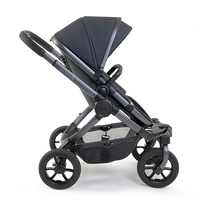

Pushchair Safety: What you Need to Know
Like any form of transport, there are a number of safety issues to consider when purchasing a pushchair for your little one. All prams and pushchairs must comply with British Standard 7409:1996 or BS EN 1888:2003. These standards set out the basic requirements for all forms of transport used to carry babies or small children.
There are a number of key safety considerations before purchasing your buggy
- Brakes = The brakes on your pram should be easy to apply. Whenever you stop always use the brake. Tyre wear can impact on how well the brakes work, so it will be important to frequently check your pram’s tyres.
- Locking = All strollers should feature two locking devices to ensure they are held together securely whilst being used. There should be no areas where little fingers could get caught in the collapsing mechanism. When putting your pram up or down your child should be out of reach and it should be assembled with care. Always follow your manufacturers instructions and don’t allow your child to play with it, as tempting as it may be to allow little one to push dolly around in the buggy! When putting your baby or child into their pram or pushchair always check the two locking devices are fully locked and secured.
- Safety Harness = Any baby or child in a pushchair needs a safety harness. This prevents your child from falling over the side or out as you steer the stroller. A 5 point harness is preferable to a 3 point harness and it should fit snuggly over the child’s shoulders, waist and between the legs. The buckles should be easy to clip together and undo. All children, regardless of their age should wear a harness while out and about.
- Stability = Always double check the stability of your pram to ensure it won’t tip over easily. Regardless of how stable your pushchair is, remember never to overload it with shopping bags, instead make use of your shopping basket. Even a stable buggy can tip over easily if too much weight is on the back.
- Backrest = If you are purchasing a stroller for a newborn, the backrest will need to be able to fully recline to allow them to lie flat until at least 3 months of age. Your child will be unable to fully sit up until roughly 6 months of age. If the backrest doesn’t fully recline you may need to consider a carrycot and upgrade to the pushchair seat as your child grows.
- Label = All pushchairs and prams should be fully labeled with the trademark, name and identity of the manufacturer, distributor or retailer.
- Weight Limit = All prams have a weight limit. Ensure you know what it is. Putting a child who is over the weight limit into a pushchair will make it very unstable and potentially cause it to tip over.
There are a number of basic safety principles you should always follow when transporting your baby or child in a buggy. When using your pram it is recommended that you get into the habit of applying the breaks every time you stop, even on flat surfaces. You should never leave your child unattended while in their stroller and it is important not to carry more children than the pram, pushchair or travel system is designed for as this may affect its reliability.
You should never leave the rain cover fitted when your child is in direct sunlight and you should remove it as soon as you get indoors to avoid your baby overheating. By observing these basic safety principles and securing baby with the harness provided, your pram should be a safe, convenient and enjoyable way for you to transport your baby.


















